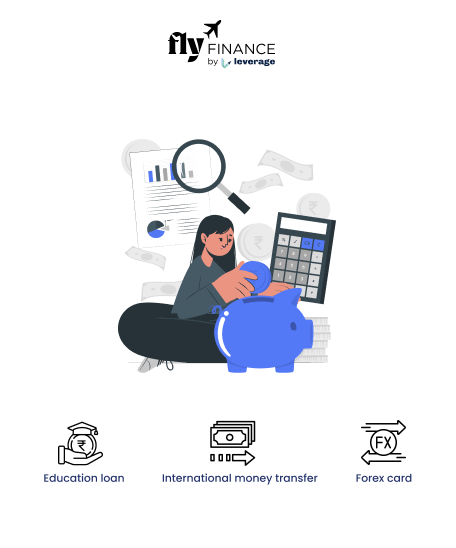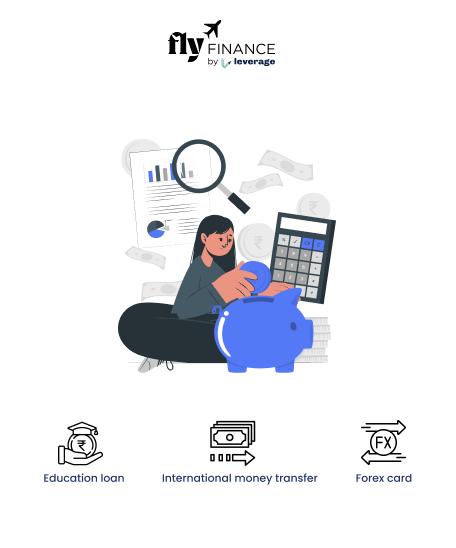Pursuing higher education, especially abroad, is a transformative journey that opens doors to global opportunities. However, the rising costs of tuition, accommodation, and travel can make this dream financially challenging. Education loans bridge this gap, but securing one involves navigating complex eligibility criteria, with the co-applicant playing a pivotal role.
This Blog introduces the importance and role of co-applicant in education loan process, offering a roadmap to understanding their role, responsibilities, and impact on your education loan application. Let’s understand this in detail.
Table of contents
- Who Is a Co-Applicant in an Education Loan?
- What is the Role of Co-Applicant in Education Loan?
- Eligibility Criteria for a Co-Applicant in Education Loan
- Responsibilities of a Co-Applicant in Loan
- How Does a Co-Applicant Impact Loan Terms?
- Co-Applicant vs. Guarantor: Key Differences
- Can You Change a Co-Applicant?
- FAQs About Co-Applicants in Education Loans
Who Is a Co-Applicant in an Education Loan?
A co-applicant is a critical figure in the education loan process, and the role of co-applicant in education loan is sharing responsibility for repayment and influencing loan approval. A co-applicant, also known as a co-borrower or co-signer, is an individual who co-signs the loan agreement with the primary applicant (typically the student).
Co-applicants share equal legal responsibility for repaying the loan to study abroad or India. If the student defaults due to unforeseen circumstances, such as unemployment post-graduation, the lender can pursue the co-applicant for repayment, mitigating financial risk.
What is the Role of Co-Applicant in Education Loan?
Understanding the role of a co-applicant in education loan is essential, especially for students who may not have a credit history or stable income. Lenders often require a co-applicant to share the responsibility of repayment, reducing the risk of default and improving the chances of loan approval.
Here are some key factors that highlight the role of a co-applicant in education loan:
- Reduces Lender Risk
One of the key roles of a co-applicant in an education loan is to offer financial security to the lender. Since students usually have limited or no income, a co-applicant—typically a parent or guardian—assures the lender of timely repayment, especially in the case of unsecured loans. - Boosts Loan Eligibility
Another significant role of a co-applicant in an education loan is enhancing the applicant’s education loan eligibility criteria. When a co-applicant’s income is added to the assessment, it increases the borrower’s ability to secure a higher loan amount to cover tuition fees, living costs, and other educational expenses. - Improves Loan Terms
The co-applicant’s financial profile plays a direct role in determining the terms of the loan. If the co-applicant has a good credit score and stable income, lenders may offer better loan conditions such as lower interest rates, longer repayment periods, and faster approval processes. - Exceptions to Co-Applicant Requirement
In select cases, some lenders may waive the need for a co-applicant. This usually applies to students with exceptional academic records or those enrolled in globally recognized institutions, as they are considered low-risk borrowers.
Also Read: Things to Know Before Applying for a foreign Education loan
Types of Co-Applicants in Education Loans
Co-Applicant in education loan are not a one-size-fits-all role; they vary based on their relationship to the borrower and financial capacity. There are two main types of co-applicants in education loan one primary and another is financial. Below outlines their distinct roles and when each is required in the loan process.
1. Primary Co-Applicant in Education Loans
The primary co-applicant is typically the first point of contact for lenders and is often a close family member. Their role involves providing moral and legal support, and they are commonly chosen for education loans, particularly for international studies.
Eligibility of a Primary Co-Applicant for Education Loans: Parents, even if retired or without steady income, can act as primary co-applicants.
2. Financial Co-Applicant in Education Loans
When the primary co-applicant lacks sufficient financial stability, a financial co-applicant steps in. Let’s understand the role of financial co-applicants, who they can be, and why their income and creditworthiness are critical for securing unsecured or high-value loans.
- Eligible Relatives: Siblings, first cousins, uncles, or aunts (paternal or maternal).
- Purpose: Ensures the loan is backed by someone with verifiable income and a strong credit score.
- When Required: Mandatory for unsecured loans or when the primary co-applicant’s income is insufficient.
Eligibility Criteria for a Co-Applicant in Education Loan
Meeting lender requirements as a co-applicant in education loan involves satisfying specific financial and personal criteria. Here is the key eligibility factors, such as income, credit score, and documentation, that co-applicants must fulfill to strengthen the loan application.
- Income Tax Returns (ITRs): Submission of ITRs for the last 2–3 years is mandatory, especially for unsecured international loans.
- Income Proof:
- Salaried Individuals: Last 6 months’ salary slips or bank statements reflecting consistent income.
- Business Owners:
- Profit and loss statements.
- GST registration proof.
- Vendor bills or invoices.
- Financial statements for the past 6 months.
- CIBIL Score: A score of 685 or higher is ideal, though some lenders accept 650+. A strong score enhances approval odds and loan terms.
- Minimum Income: A monthly income of at least INR 30,000 (net of existing debts) is typically required for international loans.
- Age: Co-applicants should be aged 21–65 years at the time of application, per standard banking norms.
Responsibilities of a Co-Applicant in Loan
The role of co-applicant in education loan extends far beyond signing paperwork; they are integral to the loan’s success. From guaranteeing repayment to providing financial documentation, let’s explore their responsibilities one by one:
- Repayment Guarantee: They are equally liable for loan repayment, stepping in if the student defaults.
- Financial Evaluation: Lenders assess their income, credit score, and liabilities to determine loan eligibility and amount.
- Documentation: Providing accurate financial documents, such as ITRs, salary slips, or business records, to complete the application.
- Credit Impact: Missed payments affect both the student’s and co-applicant’s credit scores, emphasizing the need for timely repayments.
How Does a Co-Applicant Impact Loan Terms?
A co-applicant’s financial profile significantly influences the terms of an education loan like their credit score and income affect interest rates, loan amounts, and repayment flexibility, enabling borrowers to secure more favorable terms. Let’s understand them one by one:
- Lower Interest Rates: A high CIBIL score (e.g., 750+) can secure rates as low as 10–11% p.a. for international loans.
- Higher Loan Amounts: Stable income allows borrowing up to INR 1.5 crore for unsecured loans, per lenders.
- Flexible Repayment: A strong co-applicant may extend the repayment tenure or moratorium period in education loan, easing financial pressure.
- Collateral Requirements: A reliable co-applicant can reduce or eliminate the need for collateral, even for large loans.
Co-Applicant vs. Guarantor: Key Differences
The roles of co-applicant and guarantor are often misunderstood, yet they carry distinct responsibilities. Let’s clarifies the differences between the two, using a comparison table to highlight their roles, liabilities, and involvement in the loan process.
| Criteria | Co-Applicant | Guarantor |
|---|---|---|
| Role | Co-signs the loan and shares repayment liability. | Guarantees repayment only if both borrower and co-applicant default. |
| Involvement | Actively participates in loan approval and underwriting. | Limited role; acts as a fallback. |
| Collateral | No collateral required. | May pledge assets (e.g., property). |
| Liability | Equally liable with the primary applicant. | Liable only as a last resort. |
Also Read: Planning to study abroad? Learn how to get an education loan to study abroad and cover tuition fees and living expenses.
Can You Change a Co-Applicant?
Circumstances may arise where replacing a co-applicant becomes necessary, such as financial hardship. Let’s understand the process of changing a co-applicant, including lender requirements and potential impacts on loan terms, providing clarity for borrowers facing this situation.
- Reassessment: The new co-applicant’s financial profile is evaluated, potentially altering loan terms.
- Documentation: Fresh ITRs, income proof, and credit checks are required.
- Lender Policies: Not all lenders permit substitutions; check specific terms of lenders before applying for education loan.
The role of a co-applicant in an education loan is not just a formality—it is a vital aspect of the loan process. A financially strong co-applicant can help secure better loan terms, increase eligibility, and build lender confidence in the repayment capacity. Therefore, choosing the right co-applicant is crucial when applying for an education loan.
This was all about the role of co-applicant in education loan. To learn more about education loans, the best bank accounts for students, forex, banking experience for global students, or international money transfers, reach out to our experts at 18005
FAQs About Co-Applicants in Education Loans
Navigating the co-applicant’s role can raise many questions for students and their families. This section addresses common queries about co-applicants in education loans, providing concise answers to help readers make informed decisions.
Most lenders permit up to two or three co-applicants for a student loan. However, based on the lender’s policy and the loan amount, the number of co-applicants may change.
The primary role of the co-applicant in education loan is to provide financial security by sharing legal responsibility for loan repayment. If the primary applicant defaults, the co-borrower is obligated to repay the loan. Lenders also assess the co-borrower’s income and credit score to determine loan eligibility and amount, enhancing the application’s strength.
A guarantor is someone who agrees to pay back a borrower’s debt if the borrower is unable to make loan payments. Guarantors used their real estate as collateral for the loans. Co-applicants participate in the loan underwriting and approval procedure with a borrower.
A Co-Applicant not always mandatory for education loans. In government-backed schemes like Vidya Lakshmi or loans up to INR 4 lakh may not require a co-applicant, per RBI guidelines. However, international or unsecured loans typically mandate one.
Yes, close relatives like siblings, uncles, aunts, or cousins can serve as co-applicants, provided they meet income and credit criteria. Some NBFCs, also allow friends in rare cases.
Most lenders permit 2–3 co-applicants for education loan, depending on the loan amount and their policies. Multiple co-applicants can strengthen the application.
If both the student and co-applicant fail to repay, lenders may pursue legal action or seize collateral (for secured loans). This also damages both parties’ credit scores.
Yes, in some cases, you can get an education loans without Co-signer in India. According to RBI guidelines, government-backed schemes like the Vidya Lakshmi scheme or loans up to INR 4 lakh may not require a co-applicant. However, for larger or unsecured loans, especially for international studies, lenders typically mandate a co-applicant to mitigate financial risk. Check with your lender for specific requirements.
Having a co-applicant is generally beneficial for an education loan. A co-applicant with a stable income and a good CIBIL score (preferably 685 or higher) strengthens the loan application, improves approval odds, and may secure a higher loan amount. They also reduce the lender’s risk, which can lead to better terms, such as lower interest rates. However, for smaller loans under government schemes, a co-applicant may not always be necessary.





























